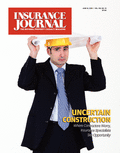Driver overconfidence is leading to risky behavior.
Nationwide’s latest driver survey found 20% of drivers text while driving, 15% use social media, 13% watch videos, and 11% read or write emails.
Half of all drivers admit to eating or drinking and 13% are getting ready for work. Nearly half of the drivers surveyed (47%) believe the growing prevalence of built-in touchscreens and displays designed for navigation, communication and entertainment contribute to driver distraction.
“Far too many people believe they’re immune to distraction or that a ‘quick check’ won’t hurt,” says Casey Kempton, Nationwide’s president of personal lines.
Roughly nine in 10 consumers feel other motorists are using their phones more behind the wheel (92%), driving faster (92%), more aggressive (92%) and more reckless (88%). Over a third of consumers agree driving is stressful for them, primarily because of others’ reckless driving, traffic congestion and navigation. Seventy-two percent said they frequently see other drivers with road rage, 66% said other drivers irritate them, and 34% said other drivers give them road rage.
Given these worries, only 15% of consumers rate other motorists around them as “very good” or “excellent” drivers, but eight in 10 rate their own driving highly.
Consumers are split on whether current distracted driving laws are effective at increasing safety on the road. Still, only about four in 10 consumers are aware of new distracted driving regulations or increased penalties for violations implemented in their state within the past two years.
Technology such as dashcams may be one solution to deter distracted driving. Of the drivers surveyed, 94% agreed that dashcams can provide valuable evidence in case of accidents or disputes during rides, but only 20% of drivers have cameras installed in their personal vehicles. About 13% of consumers have AI-powered dashcams in personal vehicles, but only 50% report they find the cameras helpful, versus 13% who find them distracting.
Seven in 10 consumers said they would be likely to enroll in a program that offers rewards based on their driving behavior, especially if they could save on their auto insurance (50%), or earn rewards such as gift cards (23%).
Topics Personal Auto
Was this article valuable?
Here are more articles you may enjoy.



 Walmart to Pay $10M to Settle FTC Lawsuit Over Money Transfer Fraud
Walmart to Pay $10M to Settle FTC Lawsuit Over Money Transfer Fraud  DeSantis Signs Law Giving Condo Owners Some Relief, But Questions Remain
DeSantis Signs Law Giving Condo Owners Some Relief, But Questions Remain  Racketeering Suit Alleges NY Insurance Fraud Scheme by Lawyers, Medical Providers
Racketeering Suit Alleges NY Insurance Fraud Scheme by Lawyers, Medical Providers  Father, Two Sons Charged With Defrauding North Carolina Insurer of Last Resort
Father, Two Sons Charged With Defrauding North Carolina Insurer of Last Resort 

